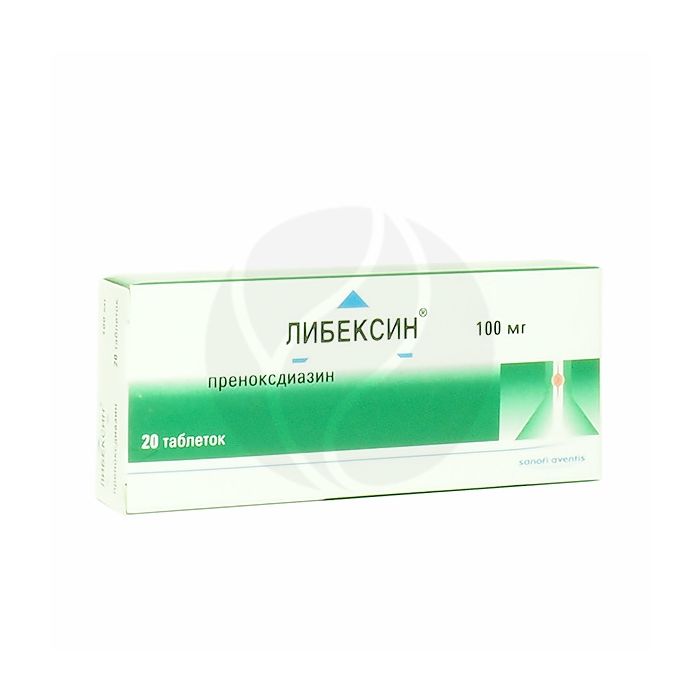Libexin tablets 100mg, No. 20
Expiration Date: 05/2027
Russian Pharmacy name:
Либексин таблетки 100мг, №20
Unproductive cough of any origin (with catarrh of the upper respiratory tract, influenza, acute and chronic bronchitis, pneumonia, emphysema);
nocturnal cough in patients with heart failure;
when preparing patients for bronchoscopic or bronchographic examination).
The average dose for adults is 100 mg 3-4 times / day (1 tablet 3-4 times / day). In more difficult cases, the dose can be increased to 200 mg 3-4 times / day or up to 300 mg 3 times / day (2 tablets 3-4 times / day or 3 tablets 3 times / day).
The average dose for children, depending on age and body weight, is 25-50 mg three or four times a day (1/4 - 1/2 tab. 3-4 times / day).
The maximum single dose for children is 50 mg (1/2 tab.), For adults - 300 mg (3 tab.).
The maximum daily dose for children is 200 mg (2 tablets), for adults - 900 mg (9 tablets).
In preparation for bronchoscopy, a dose of 0.9-3.8 mg / kg of body weight is combined with 0.5-1 mg of atropine 1 hour before the start of the procedure.
The tablets are swallowed without chewing (to avoid anesthesia of the oral mucosa).
The tablets are white or off-white, round, flat, beveled on both sides, engraved with 'LIBEXIN' on one side and a notch dividing the tablet into four parts on the other.
1 tab. prenoxdiazine hydrochloride 100 mg
Excipients: glycerol (glycerin), magnesium stearate, talc, povidone, corn starch, lactose monohydrate.
Diseases associated with profuse bronchial secretion;
condition after inhalation anesthesia;
galactose intolerance, lactase deficiency or glucose-galactose malabsorption;
hypersensitivity to the drug.
With care: children's age.
pharmachologic effect
Prenoxdiazine is a peripheral antitussive agent.
The drug blocks the peripheral links of the cough reflex due to the following effects:
local anesthetic action, which reduces irritability of the peripheral sensory (cough) receptors of the respiratory tract;
bronchodilatory action, due to which the suppression of stretch receptors involved in the cough reflex occurs; a slight decrease in the activity of the respiratory center (without respiratory depression).
The antitussive effect of the drug is approximately equal to that of codeine. Prenoxdiazine is not addictive or drug-dependent. In chronic bronchitis, the anti-inflammatory effect of prenoxdiazine has been noted. Prenoxdiazine does not affect the function of the central nervous system, with the exception of a possible indirect anxiolytic effect.
Pharmacokinetics
Prenoxdiazine is rapidly and largely absorbed from the gastrointestinal tract. Cmax of prenoxdiazine is achieved 30 minutes after taking the drug, its therapeutic concentration is maintained for 6-8 hours. The connection with plasma proteins is 55-59%. T1 / 2 is 2.6 hours. Most of the dose taken is metabolized in the liver, only about 1/3 of the dose taken is excreted unchanged, and the rest is in the form of metabolites (4 prenoxdiazine metabolites are isolated). During the first 12 hours of the metabolism of prenoxdiazine, the most important role is played by the biliary excretion of it and its metabolites. After 24 hours after administration, 93% of the drug is released. For 72 hours after ingestion, 50-74% of the dose taken is excreted in the feces and 26-50% in the urine.
Side effect
Allergic reactions: rarely - skin rash; angioedema.
From the gastrointestinal tract: rarely - dry mouth or throat; anesthesia (temporary numbness and loss of sensitivity) of the oral mucosa; in less than 10% of cases - stomach pain; a tendency to constipation; nausea.
From the nervous system: when using the drug in high doses - mild sedative effect; fatigue. It must be emphasized that both sedation and fatigue appear at doses higher than therapeutic doses, and all symptoms spontaneously disappear within a few hours after stopping the drug.
Application during pregnancy and lactation
During pregnancy and lactation, the use of Libeksin is possible only if the potential benefit to the mother outweighs the possible risk to the fetus or child. Use in children Precautions: children.
special instructions
The drug may cause gastrointestinal complaints in patients with lactose intolerance. the tablets contain lactose (0.38 mg of lactose in each tablet).
Impact on the ability to drive vehicles and perform work associated with increased danger
Taking the drug in high doses can slow down the rate of reactions, therefore, when taking the drug in high doses, the question of the possibility of driving a car or engaging in work associated with increased danger should be decided individually.
Overdose
Overdose data for humans are not available. In the case of taking a dose exceeding the therapeutic one, it is possible to develop a sedative effect and weakness.
Drug interactions
It is not recommended to combine the drug with mucolytic and expectorant drugs, because it can make it difficult to produce the phlegm that is liquefied by the latter. There is no preclinical or clinical data on interactions with other drugs.

